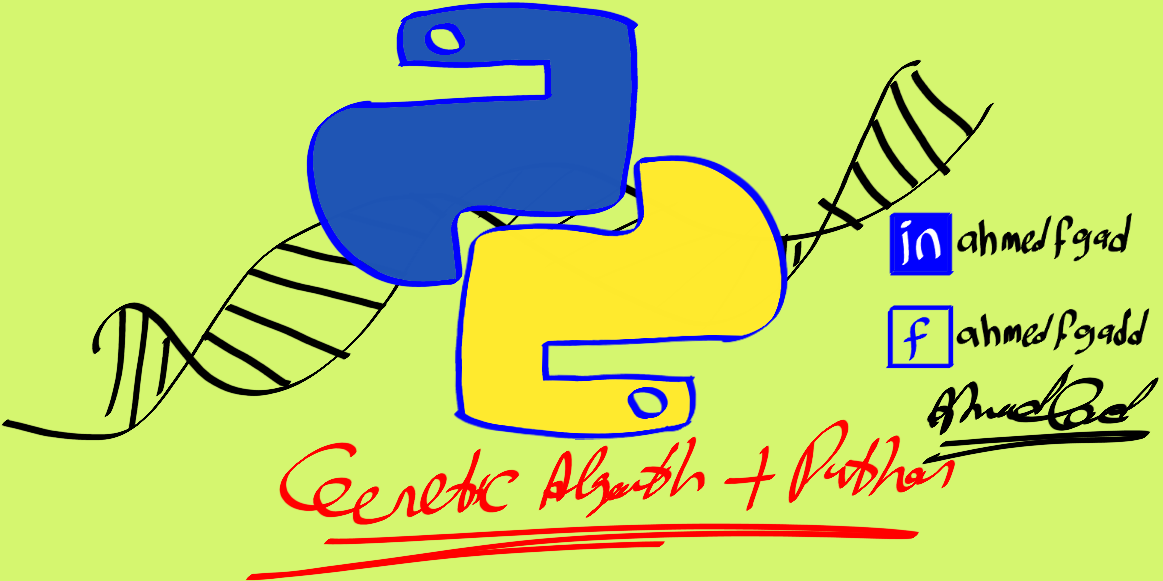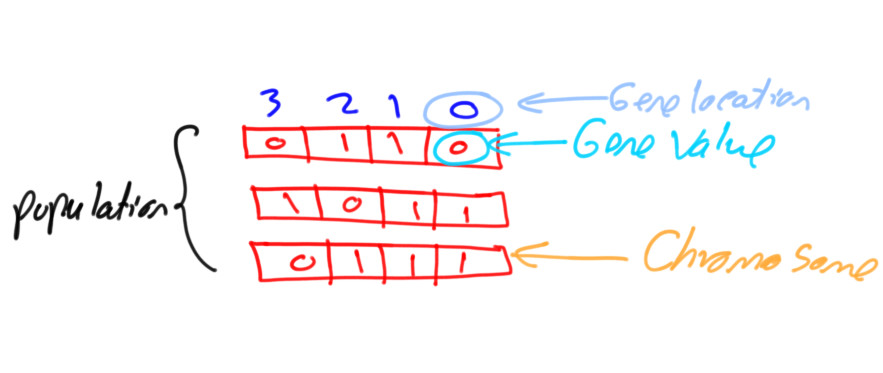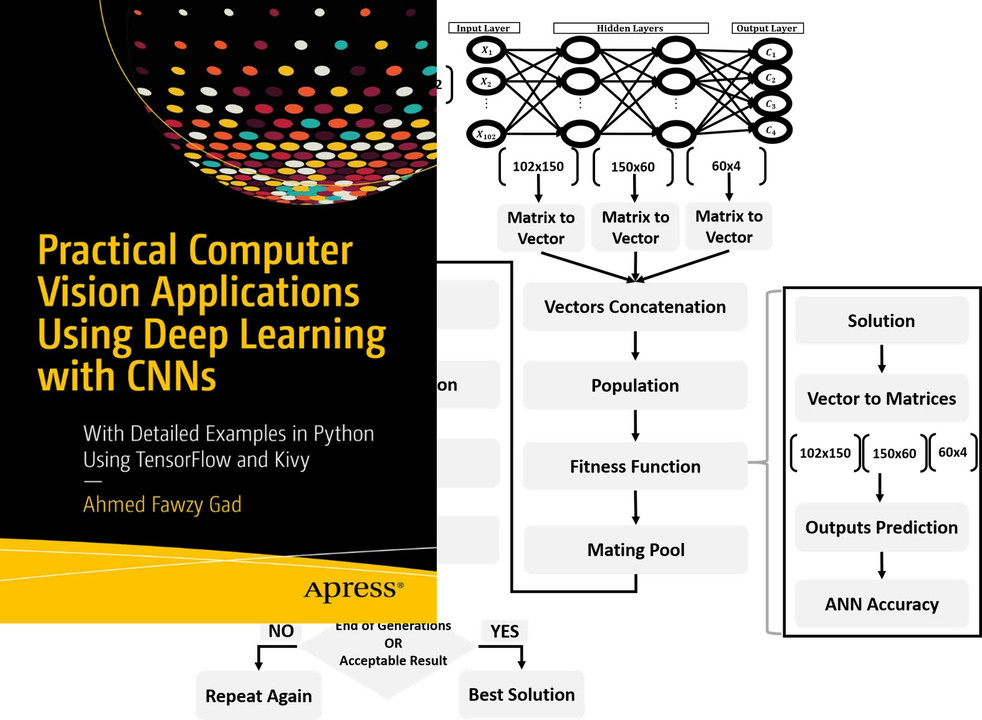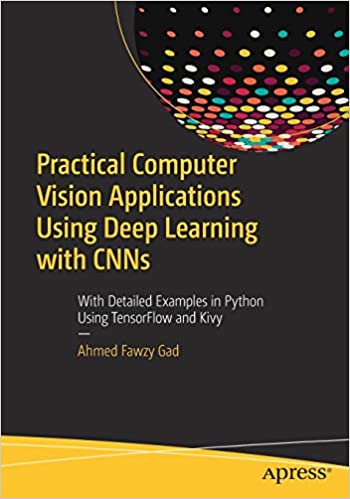| Name | pygad JSON |
| Version |
3.5.0
 JSON
JSON |
| download |
| home_page | https://github.com/ahmedfgad/GeneticAlgorithmPython |
| Summary | PyGAD: A Python Library for Building the Genetic Algorithm and Training Machine Learning Algoithms (Keras & PyTorch). |
| upload_time | 2025-07-09 02:21:48 |
| maintainer | None |
| docs_url | None |
| author | Ahmed Fawzy Gad |
| requires_python | >=3 |
| license | Copyright GeneticAlgorithmPython Contributors Redistribution and use in source and binary forms, with or without modification, are permitted provided that the following conditions are met: 1. Redistributions of source code must retain the above copyright notice, this list of conditions and the following disclaimer. 2. Redistributions in binary form must reproduce the above copyright notice, this list of conditions and the following disclaimer in the documentation and/or other materials provided with the distribution. 3. Neither the name of the copyright holder nor the names of its contributors may be used to endorse or promote products derived from this software without specific prior written permission. THIS SOFTWARE IS PROVIDED BY THE COPYRIGHT HOLDERS AND CONTRIBUTORS "AS IS" AND ANY EXPRESS OR IMPLIED WARRANTIES, INCLUDING, BUT NOT LIMITED TO, THE IMPLIED WARRANTIES OF MERCHANTABILITY AND FITNESS FOR A PARTICULAR PURPOSE ARE DISCLAIMED. IN NO EVENT SHALL THE COPYRIGHT HOLDER OR CONTRIBUTORS BE LIABLE FOR ANY DIRECT, INDIRECT, INCIDENTAL, SPECIAL, EXEMPLARY, OR CONSEQUENTIAL DAMAGES (INCLUDING, BUT NOT LIMITED TO, PROCUREMENT OF SUBSTITUTE GOODS OR SERVICES; LOSS OF USE, DATA, OR PROFITS; OR BUSINESS INTERRUPTION) HOWEVER CAUSED AND ON ANY THEORY OF LIABILITY, WHETHER IN CONTRACT, STRICT LIABILITY, OR TORT (INCLUDING NEGLIGENCE OR OTHERWISE) ARISING IN ANY WAY OUT OF THE USE OF THIS SOFTWARE, EVEN IF ADVISED OF THE POSSIBILITY OF SUCH DAMAGE. |
| keywords |
genetic algorithm
ga
optimization
evolutionary algorithm
natural evolution
pygad
machine learning
deep learning
neural networks
tensorflow
keras
pytorch
|
| VCS |
 |
| bugtrack_url |
|
| requirements |
numpy
matplotlib
cloudpickle
|
| Travis-CI |
No Travis.
|
| coveralls test coverage |
No coveralls.
|
# PyGAD: Genetic Algorithm in Python
[PyGAD](https://pypi.org/project/pygad) is an open-source easy-to-use Python 3 library for building the genetic algorithm and optimizing machine learning algorithms. It supports Keras and PyTorch. PyGAD supports optimizing both single-objective and multi-objective problems.
> Try the [Optimization Gadget](https://optimgadget.com), a free cloud-based tool powered by PyGAD. It simplifies optimization by reducing or eliminating the need for coding while providing insightful visualizations.
Check documentation of the [PyGAD](https://pygad.readthedocs.io/en/latest).
[](https://pepy.tech/project/pygad) [](
https://anaconda.org/conda-forge/PyGAD) [](https://badge.fury.io/py/pygad)[](https://github.com/ahmedfgad/GeneticAlgorithmPython/actions/workflows/main_py313.yml) [](https://github.com/ahmedfgad/GeneticAlgorithmPython/actions/workflows/main_py312.yml) [](https://github.com/ahmedfgad/GeneticAlgorithmPython/actions/workflows/main_py311.yml) [](https://github.com/ahmedfgad/GeneticAlgorithmPython/actions/workflows/main_py310.yml) [](https://github.com/ahmedfgad/GeneticAlgorithmPython/actions/workflows/main_py39.yml) [](https://github.com/ahmedfgad/GeneticAlgorithmPython/actions/workflows/main_py38.yml) [](https://opensource.org/licenses/BSD-3-Clause) [](https://hosted.weblate.org/engage/weblate/) [](https://api.reuse.software/info/github.com/WeblateOrg/weblate) [](
https://stackoverflow.com/questions/tagged/pygad) [](https://securityscorecards.dev/viewer/?uri=github.com/ahmedfgad/GeneticAlgorithmPython) [](https://doi.org/10.1007/s11042-023-17167-y)

[PyGAD](https://pypi.org/project/pygad) supports different types of crossover, mutation, and parent selection. [PyGAD](https://pypi.org/project/pygad) allows different types of problems to be optimized using the genetic algorithm by customizing the fitness function.
The library is under active development and more features are added regularly. If you want a feature to be supported, please check the **Contact Us** section to send a request.
# Donation
* [Credit/Debit Card](https://donate.stripe.com/eVa5kO866elKgM0144): https://donate.stripe.com/eVa5kO866elKgM0144
* [Open Collective](https://opencollective.com/pygad): [opencollective.com/pygad](https://opencollective.com/pygad)
* PayPal: Use either this link: [paypal.me/ahmedfgad](https://paypal.me/ahmedfgad) or the e-mail address ahmed.f.gad@gmail.com
* Interac e-Transfer: Use e-mail address ahmed.f.gad@gmail.com
# Installation
To install [PyGAD](https://pypi.org/project/pygad), simply use pip to download and install the library from [PyPI](https://pypi.org/project/pygad) (Python Package Index). The library is at PyPI at this page https://pypi.org/project/pygad.
Install PyGAD with the following command:
```python
pip install pygad
```
To get started with PyGAD, please read the documentation at [Read The Docs](https://pygad.readthedocs.io/) https://pygad.readthedocs.io.
# PyGAD Source Code
The source code of the PyGAD' modules is found in the following GitHub projects:
- [pygad](https://github.com/ahmedfgad/GeneticAlgorithmPython): (https://github.com/ahmedfgad/GeneticAlgorithmPython)
- [pygad.nn](https://github.com/ahmedfgad/NumPyANN): https://github.com/ahmedfgad/NumPyANN
- [pygad.gann](https://github.com/ahmedfgad/NeuralGenetic): https://github.com/ahmedfgad/NeuralGenetic
- [pygad.cnn](https://github.com/ahmedfgad/NumPyCNN): https://github.com/ahmedfgad/NumPyCNN
- [pygad.gacnn](https://github.com/ahmedfgad/CNNGenetic): https://github.com/ahmedfgad/CNNGenetic
- [pygad.kerasga](https://github.com/ahmedfgad/KerasGA): https://github.com/ahmedfgad/KerasGA
- [pygad.torchga](https://github.com/ahmedfgad/TorchGA): https://github.com/ahmedfgad/TorchGA
The documentation of PyGAD is available at [Read The Docs](https://pygad.readthedocs.io/) https://pygad.readthedocs.io.
# PyGAD Documentation
The documentation of the PyGAD library is available at [Read The Docs](https://pygad.readthedocs.io) at this link: https://pygad.readthedocs.io. It discusses the modules supported by PyGAD, all its classes, methods, attribute, and functions. For each module, a number of examples are given.
If there is an issue using PyGAD, feel free to post at issue in this [GitHub repository](https://github.com/ahmedfgad/GeneticAlgorithmPython) https://github.com/ahmedfgad/GeneticAlgorithmPython or by sending an e-mail to ahmed.f.gad@gmail.com.
If you built a project that uses PyGAD, then please drop an e-mail to ahmed.f.gad@gmail.com with the following information so that your project is included in the documentation.
- Project title
- Brief description
- Preferably, a link that directs the readers to your project
Please check the **Contact Us** section for more contact details.
# Life Cycle of PyGAD
The next figure lists the different stages in the lifecycle of an instance of the `pygad.GA` class. Note that PyGAD stops when either all generations are completed or when the function passed to the `on_generation` parameter returns the string `stop`.

The next code implements all the callback functions to trace the execution of the genetic algorithm. Each callback function prints its name.
```python
import pygad
import numpy
function_inputs = [4,-2,3.5,5,-11,-4.7]
desired_output = 44
def fitness_func(ga_instance, solution, solution_idx):
output = numpy.sum(solution*function_inputs)
fitness = 1.0 / (numpy.abs(output - desired_output) + 0.000001)
return fitness
fitness_function = fitness_func
def on_start(ga_instance):
print("on_start()")
def on_fitness(ga_instance, population_fitness):
print("on_fitness()")
def on_parents(ga_instance, selected_parents):
print("on_parents()")
def on_crossover(ga_instance, offspring_crossover):
print("on_crossover()")
def on_mutation(ga_instance, offspring_mutation):
print("on_mutation()")
def on_generation(ga_instance):
print("on_generation()")
def on_stop(ga_instance, last_population_fitness):
print("on_stop()")
ga_instance = pygad.GA(num_generations=3,
num_parents_mating=5,
fitness_func=fitness_function,
sol_per_pop=10,
num_genes=len(function_inputs),
on_start=on_start,
on_fitness=on_fitness,
on_parents=on_parents,
on_crossover=on_crossover,
on_mutation=on_mutation,
on_generation=on_generation,
on_stop=on_stop)
ga_instance.run()
```
Based on the used 3 generations as assigned to the `num_generations` argument, here is the output.
```
on_start()
on_fitness()
on_parents()
on_crossover()
on_mutation()
on_generation()
on_fitness()
on_parents()
on_crossover()
on_mutation()
on_generation()
on_fitness()
on_parents()
on_crossover()
on_mutation()
on_generation()
on_stop()
```
# Example
Check the [PyGAD's documentation](https://pygad.readthedocs.io/en/latest/pygad.html) for information about the implementation of this example. It solves a single-objective problem.
```python
import pygad
import numpy
"""
Given the following function:
y = f(w1:w6) = w1x1 + w2x2 + w3x3 + w4x4 + w5x5 + 6wx6
where (x1,x2,x3,x4,x5,x6)=(4,-2,3.5,5,-11,-4.7) and y=44
What are the best values for the 6 weights (w1 to w6)? We are going to use the genetic algorithm to optimize this function.
"""
function_inputs = [4,-2,3.5,5,-11,-4.7] # Function inputs.
desired_output = 44 # Function output.
def fitness_func(ga_instance, solution, solution_idx):
# Calculating the fitness value of each solution in the current population.
# The fitness function calulates the sum of products between each input and its corresponding weight.
output = numpy.sum(solution*function_inputs)
fitness = 1.0 / numpy.abs(output - desired_output)
return fitness
fitness_function = fitness_func
num_generations = 100 # Number of generations.
num_parents_mating = 7 # Number of solutions to be selected as parents in the mating pool.
# To prepare the initial population, there are 2 ways:
# 1) Prepare it yourself and pass it to the initial_population parameter. This way is useful when the user wants to start the genetic algorithm with a custom initial population.
# 2) Assign valid integer values to the sol_per_pop and num_genes parameters. If the initial_population parameter exists, then the sol_per_pop and num_genes parameters are useless.
sol_per_pop = 50 # Number of solutions in the population.
num_genes = len(function_inputs)
last_fitness = 0
def callback_generation(ga_instance):
global last_fitness
print(f"Generation = {ga_instance.generations_completed}")
print(f"Fitness = {ga_instance.best_solution()[1]}")
print(f"Change = {ga_instance.best_solution()[1] - last_fitness}")
last_fitness = ga_instance.best_solution()[1]
# Creating an instance of the GA class inside the ga module. Some parameters are initialized within the constructor.
ga_instance = pygad.GA(num_generations=num_generations,
num_parents_mating=num_parents_mating,
fitness_func=fitness_function,
sol_per_pop=sol_per_pop,
num_genes=num_genes,
on_generation=callback_generation)
# Running the GA to optimize the parameters of the function.
ga_instance.run()
# After the generations complete, some plots are showed that summarize the how the outputs/fitenss values evolve over generations.
ga_instance.plot_fitness()
# Returning the details of the best solution.
solution, solution_fitness, solution_idx = ga_instance.best_solution()
print(f"Parameters of the best solution : {solution}")
print(f"Fitness value of the best solution = {solution_fitness}")
print(f"Index of the best solution : {solution_idx}")
prediction = numpy.sum(numpy.array(function_inputs)*solution)
print(f"Predicted output based on the best solution : {prediction}")
if ga_instance.best_solution_generation != -1:
print(f"Best fitness value reached after {ga_instance.best_solution_generation} generations.")
# Saving the GA instance.
filename = 'genetic' # The filename to which the instance is saved. The name is without extension.
ga_instance.save(filename=filename)
# Loading the saved GA instance.
loaded_ga_instance = pygad.load(filename=filename)
loaded_ga_instance.plot_fitness()
```
# For More Information
There are different resources that can be used to get started with the genetic algorithm and building it in Python.
## Tutorial: Implementing Genetic Algorithm in Python
To start with coding the genetic algorithm, you can check the tutorial titled [**Genetic Algorithm Implementation in Python**](https://www.linkedin.com/pulse/genetic-algorithm-implementation-python-ahmed-gad) available at these links:
- [LinkedIn](https://www.linkedin.com/pulse/genetic-algorithm-implementation-python-ahmed-gad)
- [Towards Data Science](https://towardsdatascience.com/genetic-algorithm-implementation-in-python-5ab67bb124a6)
- [KDnuggets](https://www.kdnuggets.com/2018/07/genetic-algorithm-implementation-python.html)
[This tutorial](https://www.linkedin.com/pulse/genetic-algorithm-implementation-python-ahmed-gad) is prepared based on a previous version of the project but it still a good resource to start with coding the genetic algorithm.
[](https://www.linkedin.com/pulse/genetic-algorithm-implementation-python-ahmed-gad)
## Tutorial: Introduction to Genetic Algorithm
Get started with the genetic algorithm by reading the tutorial titled [**Introduction to Optimization with Genetic Algorithm**](https://www.linkedin.com/pulse/introduction-optimization-genetic-algorithm-ahmed-gad) which is available at these links:
* [LinkedIn](https://www.linkedin.com/pulse/introduction-optimization-genetic-algorithm-ahmed-gad)
* [Towards Data Science](https://towardsdatascience.com/introduction-to-optimization-with-genetic-algorithm-2f5001d9964b)
* [KDnuggets](https://www.kdnuggets.com/2018/03/introduction-optimization-with-genetic-algorithm.html)
[](https://www.linkedin.com/pulse/introduction-optimization-genetic-algorithm-ahmed-gad)
## Tutorial: Optimize Neural Networks with Genetic Algorithm
Read about training neural networks using the genetic algorithm through the tutorial titled [**Artificial Neural Networks Optimization using Genetic Algorithm with Python**](https://www.linkedin.com/pulse/artificial-neural-networks-optimization-using-genetic-ahmed-gad) available at these links:
- [LinkedIn](https://www.linkedin.com/pulse/artificial-neural-networks-optimization-using-genetic-ahmed-gad)
- [Towards Data Science](https://towardsdatascience.com/artificial-neural-networks-optimization-using-genetic-algorithm-with-python-1fe8ed17733e)
- [KDnuggets](https://www.kdnuggets.com/2019/03/artificial-neural-networks-optimization-genetic-algorithm-python.html)
[](https://www.linkedin.com/pulse/artificial-neural-networks-optimization-using-genetic-ahmed-gad)
## Book: Practical Computer Vision Applications Using Deep Learning with CNNs
You can also check my book cited as [**Ahmed Fawzy Gad 'Practical Computer Vision Applications Using Deep Learning with CNNs'. Dec. 2018, Apress, 978-1-4842-4167-7**](https://www.amazon.com/Practical-Computer-Vision-Applications-Learning/dp/1484241665) which discusses neural networks, convolutional neural networks, deep learning, genetic algorithm, and more.
Find the book at these links:
- [Amazon](https://www.amazon.com/Practical-Computer-Vision-Applications-Learning/dp/1484241665)
- [Springer](https://link.springer.com/book/10.1007/978-1-4842-4167-7)
- [Apress](https://www.apress.com/gp/book/9781484241660)
- [O'Reilly](https://www.oreilly.com/library/view/practical-computer-vision/9781484241677)
- [Google Books](https://books.google.com.eg/books?id=xLd9DwAAQBAJ)

# Citing PyGAD - Bibtex Formatted Citation
If you used PyGAD, please consider adding a citation to the following paper about PyGAD:
```
@article{gad2023pygad,
title={Pygad: An intuitive genetic algorithm python library},
author={Gad, Ahmed Fawzy},
journal={Multimedia Tools and Applications},
pages={1--14},
year={2023},
publisher={Springer}
}
```
# Contact Us
* E-mail: ahmed.f.gad@gmail.com
* [LinkedIn](https://www.linkedin.com/in/ahmedfgad)
* [Paperspace](https://blog.paperspace.com/author/ahmed)
* [KDnuggets](https://kdnuggets.com/author/ahmed-gad)
* [TowardsDataScience](https://towardsdatascience.com/@ahmedfgad)
* [GitHub](https://github.com/ahmedfgad)
Raw data
{
"_id": null,
"home_page": "https://github.com/ahmedfgad/GeneticAlgorithmPython",
"name": "pygad",
"maintainer": null,
"docs_url": null,
"requires_python": ">=3",
"maintainer_email": "Ahmed Gad <ahmed.f.gad@gmail.com>",
"keywords": "genetic algorithm, GA, optimization, evolutionary algorithm, natural evolution, pygad, machine learning, deep learning, neural networks, tensorflow, keras, pytorch",
"author": "Ahmed Fawzy Gad",
"author_email": "Ahmed Gad <ahmed.f.gad@gmail.com>",
"download_url": "https://files.pythonhosted.org/packages/e8/d0/931c42ef763c9b2f5d6dc66d082df4a977f8deb415cf802c031551fb39b2/pygad-3.5.0.tar.gz",
"platform": null,
"description": "# PyGAD: Genetic Algorithm in Python\n\n[PyGAD](https://pypi.org/project/pygad) is an open-source easy-to-use Python 3 library for building the genetic algorithm and optimizing machine learning algorithms. It supports Keras and PyTorch. PyGAD supports optimizing both single-objective and multi-objective problems.\n\n> Try the [Optimization Gadget](https://optimgadget.com), a free cloud-based tool powered by PyGAD. It simplifies optimization by reducing or eliminating the need for coding while providing insightful visualizations.\n\nCheck documentation of the [PyGAD](https://pygad.readthedocs.io/en/latest).\n\n[](https://pepy.tech/project/pygad) [](\nhttps://anaconda.org/conda-forge/PyGAD) [](https://badge.fury.io/py/pygad)[](https://github.com/ahmedfgad/GeneticAlgorithmPython/actions/workflows/main_py313.yml) [](https://github.com/ahmedfgad/GeneticAlgorithmPython/actions/workflows/main_py312.yml) [](https://github.com/ahmedfgad/GeneticAlgorithmPython/actions/workflows/main_py311.yml) [](https://github.com/ahmedfgad/GeneticAlgorithmPython/actions/workflows/main_py310.yml) [](https://github.com/ahmedfgad/GeneticAlgorithmPython/actions/workflows/main_py39.yml) [](https://github.com/ahmedfgad/GeneticAlgorithmPython/actions/workflows/main_py38.yml) [](https://opensource.org/licenses/BSD-3-Clause) [](https://hosted.weblate.org/engage/weblate/) [](https://api.reuse.software/info/github.com/WeblateOrg/weblate) [](\nhttps://stackoverflow.com/questions/tagged/pygad) [](https://securityscorecards.dev/viewer/?uri=github.com/ahmedfgad/GeneticAlgorithmPython) [](https://doi.org/10.1007/s11042-023-17167-y)\n\n\n\n[PyGAD](https://pypi.org/project/pygad) supports different types of crossover, mutation, and parent selection. [PyGAD](https://pypi.org/project/pygad) allows different types of problems to be optimized using the genetic algorithm by customizing the fitness function. \n\nThe library is under active development and more features are added regularly. If you want a feature to be supported, please check the **Contact Us** section to send a request.\n\n# Donation\n\n* [Credit/Debit Card](https://donate.stripe.com/eVa5kO866elKgM0144): https://donate.stripe.com/eVa5kO866elKgM0144\n* [Open Collective](https://opencollective.com/pygad): [opencollective.com/pygad](https://opencollective.com/pygad)\n* PayPal: Use either this link: [paypal.me/ahmedfgad](https://paypal.me/ahmedfgad) or the e-mail address ahmed.f.gad@gmail.com\n* Interac e-Transfer: Use e-mail address ahmed.f.gad@gmail.com\n\n# Installation\n\nTo install [PyGAD](https://pypi.org/project/pygad), simply use pip to download and install the library from [PyPI](https://pypi.org/project/pygad) (Python Package Index). The library is at PyPI at this page https://pypi.org/project/pygad.\n\nInstall PyGAD with the following command:\n\n```python\npip install pygad\n```\n\nTo get started with PyGAD, please read the documentation at [Read The Docs](https://pygad.readthedocs.io/) https://pygad.readthedocs.io.\n\n# PyGAD Source Code\n\nThe source code of the PyGAD' modules is found in the following GitHub projects:\n\n- [pygad](https://github.com/ahmedfgad/GeneticAlgorithmPython): (https://github.com/ahmedfgad/GeneticAlgorithmPython)\n- [pygad.nn](https://github.com/ahmedfgad/NumPyANN): https://github.com/ahmedfgad/NumPyANN\n- [pygad.gann](https://github.com/ahmedfgad/NeuralGenetic): https://github.com/ahmedfgad/NeuralGenetic\n- [pygad.cnn](https://github.com/ahmedfgad/NumPyCNN): https://github.com/ahmedfgad/NumPyCNN\n- [pygad.gacnn](https://github.com/ahmedfgad/CNNGenetic): https://github.com/ahmedfgad/CNNGenetic\n- [pygad.kerasga](https://github.com/ahmedfgad/KerasGA): https://github.com/ahmedfgad/KerasGA\n- [pygad.torchga](https://github.com/ahmedfgad/TorchGA): https://github.com/ahmedfgad/TorchGA\n\nThe documentation of PyGAD is available at [Read The Docs](https://pygad.readthedocs.io/) https://pygad.readthedocs.io.\n\n# PyGAD Documentation\n\nThe documentation of the PyGAD library is available at [Read The Docs](https://pygad.readthedocs.io) at this link: https://pygad.readthedocs.io. It discusses the modules supported by PyGAD, all its classes, methods, attribute, and functions. For each module, a number of examples are given.\n\nIf there is an issue using PyGAD, feel free to post at issue in this [GitHub repository](https://github.com/ahmedfgad/GeneticAlgorithmPython) https://github.com/ahmedfgad/GeneticAlgorithmPython or by sending an e-mail to ahmed.f.gad@gmail.com. \n\nIf you built a project that uses PyGAD, then please drop an e-mail to ahmed.f.gad@gmail.com with the following information so that your project is included in the documentation.\n\n- Project title\n- Brief description\n- Preferably, a link that directs the readers to your project\n\nPlease check the **Contact Us** section for more contact details.\n\n# Life Cycle of PyGAD\n\nThe next figure lists the different stages in the lifecycle of an instance of the `pygad.GA` class. Note that PyGAD stops when either all generations are completed or when the function passed to the `on_generation` parameter returns the string `stop`.\n\n\n\nThe next code implements all the callback functions to trace the execution of the genetic algorithm. Each callback function prints its name.\n\n```python\nimport pygad\nimport numpy\n\nfunction_inputs = [4,-2,3.5,5,-11,-4.7]\ndesired_output = 44\n\ndef fitness_func(ga_instance, solution, solution_idx):\n output = numpy.sum(solution*function_inputs)\n fitness = 1.0 / (numpy.abs(output - desired_output) + 0.000001)\n return fitness\n\nfitness_function = fitness_func\n\ndef on_start(ga_instance):\n print(\"on_start()\")\n\ndef on_fitness(ga_instance, population_fitness):\n print(\"on_fitness()\")\n\ndef on_parents(ga_instance, selected_parents):\n print(\"on_parents()\")\n\ndef on_crossover(ga_instance, offspring_crossover):\n print(\"on_crossover()\")\n\ndef on_mutation(ga_instance, offspring_mutation):\n print(\"on_mutation()\")\n\ndef on_generation(ga_instance):\n print(\"on_generation()\")\n\ndef on_stop(ga_instance, last_population_fitness):\n print(\"on_stop()\")\n\nga_instance = pygad.GA(num_generations=3,\n num_parents_mating=5,\n fitness_func=fitness_function,\n sol_per_pop=10,\n num_genes=len(function_inputs),\n on_start=on_start,\n on_fitness=on_fitness,\n on_parents=on_parents,\n on_crossover=on_crossover,\n on_mutation=on_mutation,\n on_generation=on_generation,\n on_stop=on_stop)\n\nga_instance.run()\n```\n\nBased on the used 3 generations as assigned to the `num_generations` argument, here is the output.\n\n```\non_start()\n\non_fitness()\non_parents()\non_crossover()\non_mutation()\non_generation()\n\non_fitness()\non_parents()\non_crossover()\non_mutation()\non_generation()\n\non_fitness()\non_parents()\non_crossover()\non_mutation()\non_generation()\n\non_stop()\n```\n\n# Example\n\nCheck the [PyGAD's documentation](https://pygad.readthedocs.io/en/latest/pygad.html) for information about the implementation of this example. It solves a single-objective problem.\n\n```python\nimport pygad\nimport numpy\n\n\"\"\"\nGiven the following function:\n y = f(w1:w6) = w1x1 + w2x2 + w3x3 + w4x4 + w5x5 + 6wx6\n where (x1,x2,x3,x4,x5,x6)=(4,-2,3.5,5,-11,-4.7) and y=44\nWhat are the best values for the 6 weights (w1 to w6)? We are going to use the genetic algorithm to optimize this function.\n\"\"\"\n\nfunction_inputs = [4,-2,3.5,5,-11,-4.7] # Function inputs.\ndesired_output = 44 # Function output.\n\ndef fitness_func(ga_instance, solution, solution_idx):\n # Calculating the fitness value of each solution in the current population.\n # The fitness function calulates the sum of products between each input and its corresponding weight.\n output = numpy.sum(solution*function_inputs)\n fitness = 1.0 / numpy.abs(output - desired_output)\n return fitness\n\nfitness_function = fitness_func\n\nnum_generations = 100 # Number of generations.\nnum_parents_mating = 7 # Number of solutions to be selected as parents in the mating pool.\n\n# To prepare the initial population, there are 2 ways:\n# 1) Prepare it yourself and pass it to the initial_population parameter. This way is useful when the user wants to start the genetic algorithm with a custom initial population.\n# 2) Assign valid integer values to the sol_per_pop and num_genes parameters. If the initial_population parameter exists, then the sol_per_pop and num_genes parameters are useless.\nsol_per_pop = 50 # Number of solutions in the population.\nnum_genes = len(function_inputs)\n\nlast_fitness = 0\ndef callback_generation(ga_instance):\n global last_fitness\n print(f\"Generation = {ga_instance.generations_completed}\")\n print(f\"Fitness = {ga_instance.best_solution()[1]}\")\n print(f\"Change = {ga_instance.best_solution()[1] - last_fitness}\")\n last_fitness = ga_instance.best_solution()[1]\n\n# Creating an instance of the GA class inside the ga module. Some parameters are initialized within the constructor.\nga_instance = pygad.GA(num_generations=num_generations,\n num_parents_mating=num_parents_mating, \n fitness_func=fitness_function,\n sol_per_pop=sol_per_pop, \n num_genes=num_genes,\n on_generation=callback_generation)\n\n# Running the GA to optimize the parameters of the function.\nga_instance.run()\n\n# After the generations complete, some plots are showed that summarize the how the outputs/fitenss values evolve over generations.\nga_instance.plot_fitness()\n\n# Returning the details of the best solution.\nsolution, solution_fitness, solution_idx = ga_instance.best_solution()\nprint(f\"Parameters of the best solution : {solution}\")\nprint(f\"Fitness value of the best solution = {solution_fitness}\")\nprint(f\"Index of the best solution : {solution_idx}\")\n\nprediction = numpy.sum(numpy.array(function_inputs)*solution)\nprint(f\"Predicted output based on the best solution : {prediction}\")\n\nif ga_instance.best_solution_generation != -1:\n print(f\"Best fitness value reached after {ga_instance.best_solution_generation} generations.\")\n\n# Saving the GA instance.\nfilename = 'genetic' # The filename to which the instance is saved. The name is without extension.\nga_instance.save(filename=filename)\n\n# Loading the saved GA instance.\nloaded_ga_instance = pygad.load(filename=filename)\nloaded_ga_instance.plot_fitness()\n```\n\n# For More Information\n\nThere are different resources that can be used to get started with the genetic algorithm and building it in Python. \n\n## Tutorial: Implementing Genetic Algorithm in Python\n\nTo start with coding the genetic algorithm, you can check the tutorial titled [**Genetic Algorithm Implementation in Python**](https://www.linkedin.com/pulse/genetic-algorithm-implementation-python-ahmed-gad) available at these links:\n\n- [LinkedIn](https://www.linkedin.com/pulse/genetic-algorithm-implementation-python-ahmed-gad)\n- [Towards Data Science](https://towardsdatascience.com/genetic-algorithm-implementation-in-python-5ab67bb124a6)\n- [KDnuggets](https://www.kdnuggets.com/2018/07/genetic-algorithm-implementation-python.html)\n\n[This tutorial](https://www.linkedin.com/pulse/genetic-algorithm-implementation-python-ahmed-gad) is prepared based on a previous version of the project but it still a good resource to start with coding the genetic algorithm.\n\n[](https://www.linkedin.com/pulse/genetic-algorithm-implementation-python-ahmed-gad)\n\n## Tutorial: Introduction to Genetic Algorithm\n\nGet started with the genetic algorithm by reading the tutorial titled [**Introduction to Optimization with Genetic Algorithm**](https://www.linkedin.com/pulse/introduction-optimization-genetic-algorithm-ahmed-gad) which is available at these links:\n\n* [LinkedIn](https://www.linkedin.com/pulse/introduction-optimization-genetic-algorithm-ahmed-gad)\n* [Towards Data Science](https://towardsdatascience.com/introduction-to-optimization-with-genetic-algorithm-2f5001d9964b)\n* [KDnuggets](https://www.kdnuggets.com/2018/03/introduction-optimization-with-genetic-algorithm.html)\n\n[](https://www.linkedin.com/pulse/introduction-optimization-genetic-algorithm-ahmed-gad)\n\n## Tutorial: Optimize Neural Networks with Genetic Algorithm\n\nRead about training neural networks using the genetic algorithm through the tutorial titled [**Artificial Neural Networks Optimization using Genetic Algorithm with Python**](https://www.linkedin.com/pulse/artificial-neural-networks-optimization-using-genetic-ahmed-gad) available at these links:\n\n- [LinkedIn](https://www.linkedin.com/pulse/artificial-neural-networks-optimization-using-genetic-ahmed-gad)\n- [Towards Data Science](https://towardsdatascience.com/artificial-neural-networks-optimization-using-genetic-algorithm-with-python-1fe8ed17733e)\n- [KDnuggets](https://www.kdnuggets.com/2019/03/artificial-neural-networks-optimization-genetic-algorithm-python.html)\n\n[](https://www.linkedin.com/pulse/artificial-neural-networks-optimization-using-genetic-ahmed-gad)\n\n## Book: Practical Computer Vision Applications Using Deep Learning with CNNs\n\nYou can also check my book cited as [**Ahmed Fawzy Gad 'Practical Computer Vision Applications Using Deep Learning with CNNs'. Dec. 2018, Apress, 978-1-4842-4167-7**](https://www.amazon.com/Practical-Computer-Vision-Applications-Learning/dp/1484241665) which discusses neural networks, convolutional neural networks, deep learning, genetic algorithm, and more.\n\nFind the book at these links:\n\n- [Amazon](https://www.amazon.com/Practical-Computer-Vision-Applications-Learning/dp/1484241665)\n- [Springer](https://link.springer.com/book/10.1007/978-1-4842-4167-7)\n- [Apress](https://www.apress.com/gp/book/9781484241660)\n- [O'Reilly](https://www.oreilly.com/library/view/practical-computer-vision/9781484241677)\n- [Google Books](https://books.google.com.eg/books?id=xLd9DwAAQBAJ)\n\n\n\n# Citing PyGAD - Bibtex Formatted Citation\n\nIf you used PyGAD, please consider adding a citation to the following paper about PyGAD:\n\n```\n@article{gad2023pygad,\n title={Pygad: An intuitive genetic algorithm python library},\n author={Gad, Ahmed Fawzy},\n journal={Multimedia Tools and Applications},\n pages={1--14},\n year={2023},\n publisher={Springer}\n}\n```\n\n# Contact Us\n\n* E-mail: ahmed.f.gad@gmail.com\n* [LinkedIn](https://www.linkedin.com/in/ahmedfgad)\n* [Paperspace](https://blog.paperspace.com/author/ahmed)\n* [KDnuggets](https://kdnuggets.com/author/ahmed-gad)\n* [TowardsDataScience](https://towardsdatascience.com/@ahmedfgad)\n* [GitHub](https://github.com/ahmedfgad)\n",
"bugtrack_url": null,
"license": "Copyright GeneticAlgorithmPython Contributors Redistribution and use in source and binary forms, with or without modification, are permitted provided that the following conditions are met: 1. Redistributions of source code must retain the above copyright notice, this list of conditions and the following disclaimer. 2. Redistributions in binary form must reproduce the above copyright notice, this list of conditions and the following disclaimer in the documentation and/or other materials provided with the distribution. 3. Neither the name of the copyright holder nor the names of its contributors may be used to endorse or promote products derived from this software without specific prior written permission. THIS SOFTWARE IS PROVIDED BY THE COPYRIGHT HOLDERS AND CONTRIBUTORS \"AS IS\" AND ANY EXPRESS OR IMPLIED WARRANTIES, INCLUDING, BUT NOT LIMITED TO, THE IMPLIED WARRANTIES OF MERCHANTABILITY AND FITNESS FOR A PARTICULAR PURPOSE ARE DISCLAIMED. IN NO EVENT SHALL THE COPYRIGHT HOLDER OR CONTRIBUTORS BE LIABLE FOR ANY DIRECT, INDIRECT, INCIDENTAL, SPECIAL, EXEMPLARY, OR CONSEQUENTIAL DAMAGES (INCLUDING, BUT NOT LIMITED TO, PROCUREMENT OF SUBSTITUTE GOODS OR SERVICES; LOSS OF USE, DATA, OR PROFITS; OR BUSINESS INTERRUPTION) HOWEVER CAUSED AND ON ANY THEORY OF LIABILITY, WHETHER IN CONTRACT, STRICT LIABILITY, OR TORT (INCLUDING NEGLIGENCE OR OTHERWISE) ARISING IN ANY WAY OUT OF THE USE OF THIS SOFTWARE, EVEN IF ADVISED OF THE POSSIBILITY OF SUCH DAMAGE. ",
"summary": "PyGAD: A Python Library for Building the Genetic Algorithm and Training Machine Learning Algoithms (Keras & PyTorch).",
"version": "3.5.0",
"project_urls": {
"Conda Forge Project": "https://anaconda.org/conda-forge/pygad",
"Documentation": "https://pygad.readthedocs.io",
"Donation Open Collective": "https://opencollective.com/pygad",
"Donation Paypal": "http://paypal.me/ahmedfgad",
"Donation Stripe": "https://donate.stripe.com/eVa5kO866elKgM0144",
"GitHub Repository": "https://github.com/ahmedfgad/GeneticAlgorithmPython",
"Homepage": "https://github.com/ahmedfgad/GeneticAlgorithmPython",
"PyPI Project": "https://pypi.org/project/pygad"
},
"split_keywords": [
"genetic algorithm",
" ga",
" optimization",
" evolutionary algorithm",
" natural evolution",
" pygad",
" machine learning",
" deep learning",
" neural networks",
" tensorflow",
" keras",
" pytorch"
],
"urls": [
{
"comment_text": "",
"digests": {
"blake2b_256": "e98dddc7746eecc1f53dba43b757bc5e87614ee4ea1712ad9157cf5aa3772e1b",
"md5": "2223e5f267edebfa6f8354b5fa8a776f",
"sha256": "80d155f09f7369c305cf4d0ac5279d0a0f5a98cb935b1ce0d8413865c41b690d"
},
"downloads": -1,
"filename": "pygad-3.5.0-py3-none-any.whl",
"has_sig": false,
"md5_digest": "2223e5f267edebfa6f8354b5fa8a776f",
"packagetype": "bdist_wheel",
"python_version": "py3",
"requires_python": ">=3",
"size": 89590,
"upload_time": "2025-07-09T02:21:47",
"upload_time_iso_8601": "2025-07-09T02:21:47.222227Z",
"url": "https://files.pythonhosted.org/packages/e9/8d/ddc7746eecc1f53dba43b757bc5e87614ee4ea1712ad9157cf5aa3772e1b/pygad-3.5.0-py3-none-any.whl",
"yanked": false,
"yanked_reason": null
},
{
"comment_text": "",
"digests": {
"blake2b_256": "e8d0931c42ef763c9b2f5d6dc66d082df4a977f8deb415cf802c031551fb39b2",
"md5": "ec56f326e537f3626c9de032b8d90403",
"sha256": "18c5b7ad274375206d7b78adc63fc9725a2d655b90c8296e14cc03c0f535797e"
},
"downloads": -1,
"filename": "pygad-3.5.0.tar.gz",
"has_sig": false,
"md5_digest": "ec56f326e537f3626c9de032b8d90403",
"packagetype": "sdist",
"python_version": "source",
"requires_python": ">=3",
"size": 109839,
"upload_time": "2025-07-09T02:21:48",
"upload_time_iso_8601": "2025-07-09T02:21:48.756687Z",
"url": "https://files.pythonhosted.org/packages/e8/d0/931c42ef763c9b2f5d6dc66d082df4a977f8deb415cf802c031551fb39b2/pygad-3.5.0.tar.gz",
"yanked": false,
"yanked_reason": null
}
],
"upload_time": "2025-07-09 02:21:48",
"github": true,
"gitlab": false,
"bitbucket": false,
"codeberg": false,
"github_user": "ahmedfgad",
"github_project": "GeneticAlgorithmPython",
"travis_ci": false,
"coveralls": false,
"github_actions": true,
"requirements": [
{
"name": "numpy",
"specs": []
},
{
"name": "matplotlib",
"specs": []
},
{
"name": "cloudpickle",
"specs": []
}
],
"lcname": "pygad"
}
